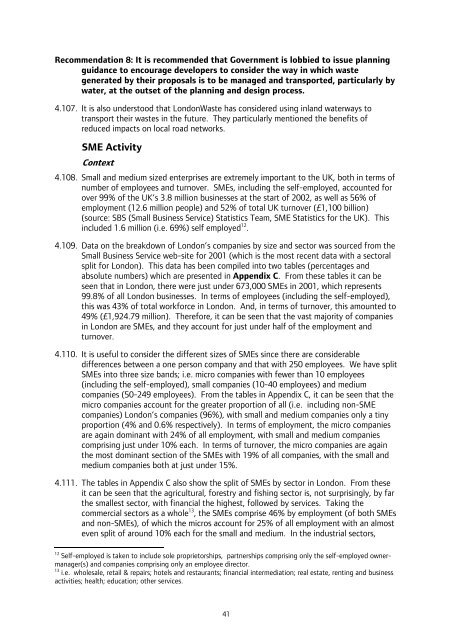London Wider Waste Strategy - London - Greater London Authority
London Wider Waste Strategy - London - Greater London Authority
London Wider Waste Strategy - London - Greater London Authority
You also want an ePaper? Increase the reach of your titles
YUMPU automatically turns print PDFs into web optimized ePapers that Google loves.
Recommendation 8: It is recommended that Government is lobbied to issue planning<br />
guidance to encourage developers to consider the way in which waste<br />
generated by their proposals is to be managed and transported, particularly by<br />
water, at the outset of the planning and design process.<br />
4.107. It is also understood that <strong>London</strong><strong>Waste</strong> has considered using inland waterways to<br />
transport their wastes in the future. They particularly mentioned the benefits of<br />
reduced impacts on local road networks.<br />
SME Activity<br />
Context<br />
4.108. Small and medium sized enterprises are extremely important to the UK, both in terms of<br />
number of employees and turnover. SMEs, including the self-employed, accounted for<br />
over 99% of the UK’s 3.8 million businesses at the start of 2002, as well as 56% of<br />
employment (12.6 million people) and 52% of total UK turnover (£1,100 billion)<br />
(source: SBS (Small Business Service) Statistics Team, SME Statistics for the UK). This<br />
included 1.6 million (i.e. 69%) self employed 12 .<br />
4.109. Data on the breakdown of <strong>London</strong>’s companies by size and sector was sourced from the<br />
Small Business Service web-site for 2001 (which is the most recent data with a sectoral<br />
split for <strong>London</strong>). This data has been compiled into two tables (percentages and<br />
absolute numbers) which are presented in Appendix C. From these tables it can be<br />
seen that in <strong>London</strong>, there were just under 673,000 SMEs in 2001, which represents<br />
99.8% of all <strong>London</strong> businesses. In terms of employees (including the self-employed),<br />
this was 43% of total workforce in <strong>London</strong>. And, in terms of turnover, this amounted to<br />
49% (£1,924.79 million). Therefore, it can be seen that the vast majority of companies<br />
in <strong>London</strong> are SMEs, and they account for just under half of the employment and<br />
turnover.<br />
4.110. It is useful to consider the different sizes of SMEs since there are considerable<br />
differences between a one person company and that with 250 employees. We have split<br />
SMEs into three size bands; i.e. micro companies with fewer than 10 employees<br />
(including the self-employed), small companies (10-40 employees) and medium<br />
companies (50-249 employees). From the tables in Appendix C, it can be seen that the<br />
micro companies account for the greater proportion of all (i.e. including non-SME<br />
companies) <strong>London</strong>’s companies (96%), with small and medium companies only a tiny<br />
proportion (4% and 0.6% respectively). In terms of employment, the micro companies<br />
are again dominant with 24% of all employment, with small and medium companies<br />
comprising just under 10% each. In terms of turnover, the micro companies are again<br />
the most dominant section of the SMEs with 19% of all companies, with the small and<br />
medium companies both at just under 15%.<br />
4.111. The tables in Appendix C also show the split of SMEs by sector in <strong>London</strong>. From these<br />
it can be seen that the agricultural, forestry and fishing sector is, not surprisingly, by far<br />
the smallest sector, with financial the highest, followed by services. Taking the<br />
commercial sectors as a whole 13 , the SMEs comprise 46% by employment (of both SMEs<br />
and non-SMEs), of which the micros account for 25% of all employment with an almost<br />
even split of around 10% each for the small and medium. In the industrial sectors,<br />
12 Self-employed is taken to include sole proprietorships, partnerships comprising only the self-employed ownermanager(s)<br />
and companies comprising only an employee director.<br />
13 i.e. wholesale, retail & repairs; hotels and restaurants; financial intermediation; real estate, renting and business<br />
activities; health; education; other services.<br />
41
















